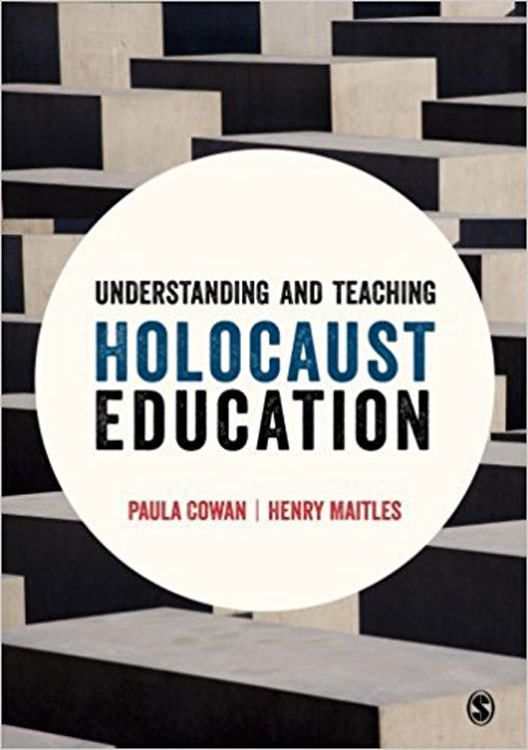Paula Cowan and Henry Maitles
Understanding and Teaching Holocaust Education
(London: SAGE, 2017), 184 pages.
ISBN: 978-1-4739-1934-1
Cowan and Maitles have taught courses on Holocaust Studies and Citizenship at the University of the West of Scotland. In their new eleven-chapter book, the authors highlight many of the key issues in contemporary Holocaust education. They devote sections to pedagogical practices, age-appropriate approaches, study visits to authentic Holocaust-related historical sites, antisemitism, contemporary historical narratives and more. This reviewer hopes that many pre-service teachers in the United Kingdom and around the world will find this new book useful as they study how to teach about the Holocaust.
The authors seek to appeal to a broad audience, including educators who already teach about the Holocaust and those who are looking to tackle this challenging topic in their classrooms for the first time. The book has a strong focus on formal education, yet it may also be a useful resource for educators who teach outside the traditional classroom setting, such as docents. The authors make a cogent case that educators “require support in teaching the Holocaust.”
Cowan and Maitles acknowledge that different countries have different needs and therefore grapple with different challenges, such as competing historical narratives. Holocaust commemoration may contribute to students’ understanding about the Holocaust, but these ceremonies cannot take the place of educational processes. Moreover, the authors further contend that “the representation of the Holocaust that is adopted at commemorative events is a particular representation that appeals to the populace and facilitates an understanding of the Holocaust that, by its concealment of important factors, leads to a perception that the Holocaust was gentler than its barbaric and cruel reality.”
In Chapter 6, Cowan and Maitles maintain that educators should be consistent in their use of language, clarifying terms in Holocaust education. They assert that teachers have a professional responsibility to communicate key messages to students in their classrooms, such as by exercising caution when referring to “camps,” for example. The authors believe that “students have a better chance of understanding the Holocaust and of understanding survivor testimony if educators have knowledge of the different types of camps and of the appropriate terminology to convey this knowledge.”
In Chapter 9, the authors focus on practical classroom teaching strategies and tools. They argue that educators should fully explore pedagogical issues before considering simulation and role play in their classrooms. However, Cowan and Maitles also state that when “exercising caution, and putting the simulation explicitly and appropriately into its historical context” this method “can work very well.” According to the authors, “If done well, the simulation approach can contribute in a meaningful way to a better understanding of the Holocaust and citizenship." This reviewer has serious reservations with this assertion. Most teachers lack fundamental knowledge of the complexity of this historical period and adequate class time to conduct simulations of educational value.
To their credit, the authors clearly state in their introduction that they are concerned that “many teachers do not regard Nazi policy towards the Jews as substantively different from that for the other groups of people.” In their view, Nazi Germany’s distinctive policy vis-à-vis the Jewish people during this period is “fundamental to understanding the Holocaust.”
In the epilogue, the authors rightly underscore that the "de-Judaization" of the Holocaust is a real concern. They assert, “Teachers and educators who neither recognize [that the Nazis wanted to kill every Jewish person living in Europe], nor the district treatment of the Jews as victims of Nazism, in their understanding of the Holocaust, are marginalizing the Jewish experience in the Holocaust. The impact of this understanding of the Holocaust will impact on their pedagogy and practice and has the potential to distort students’ understanding of the Holocaust.” Ironically, this book was published just a few weeks prior to US President Donald Trump’s statement on January 27, 2017. That statement, which the White House issued for International Holocaust Remembrance Day, failed to mention Jews or antisemitism even once.
This book does have a few shortcomings. For example, the Timeline of Holocaust Education is useful, but it lacks an important reference to a decision by the ministers of education of the Council of Europe to designate a day of remembrance in member states' schools. In addition, lists of recommended media at the end of the chapters are not very comprehensive, nor do they include video presentations that might be useful to the book's specified target audiences.
In the epilogue, the authors cite their research findings that studying the Holocaust had an impact on their students above and beyond their classroom experience. Their students related what they had learned about this topic to family and friends, “reporting that their study of the Holocaust had made them more passionate about their teaching in general, and about teaching about genocide and the Holocaust in particular.”
Cowan and Maitles have successfully shed light on a number of important topics, including controversial issues, in Holocaust education today. Despite a few reservations about a number of methodological concepts that the authors have highlighted, this reviewer believes that experienced and in-training Holocaust educators alike will find this book to be useful.







